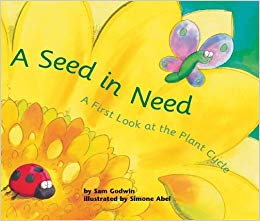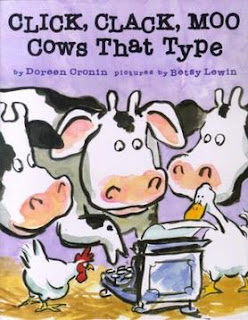Science Content in Children's Literature
Thank you for stopping by She Reads Books
today. I am so thrilled you decided to stop by! Today I will be
sharing my reviews on five science content books in children's literature and how I would use the books in my future
classroom. I hope you enjoy my picks!
Book #1: A Seed in Need by Sam Godwin
Book Review: A Seed in Need is a little complex
and relatively short read for children. However, it is not too complex to where
students in first grade or beyond would not understand what is occurring throughout
the story. This story is an entertaining book about the life cycle of a plant. This
book incorporates the plant life cycle, what plants need to survive, and the
parts of a plant. I recommend this book to any teacher and parent to read to
their students and children because the illustrations are entertaining, and it
keeps the children engaged while learning about the plant life cycle.
Lesson Idea: In my future classroom, I would love to
use this book as a read-aloud to aid in teaching the plant life cycle. One
lesson idea I have for this book is to teach the plant life cycle by having my
students complete a plant life cycle experiment booklet. Basically, they would
write in their booklets first what plants need to survive, how they planted the
seed, and then for the next few weeks they would draw what was occurring in
their cup where the seed is planted. In addition, they would note any changes
that has occurred and if they have watered their plant or not.
Below I have attached a link
to a read-aloud of the story in case you wanted to check out the story!
Read-Aloud: https://www.youtube.com/watch?v=lxYazAokfDQ
Book #2: Monarch Butterfly by David M. Schwartz
Book Review: Monarch Butterfly is a little
complex and relatively short read for children. This book discusses the life
cycle of a butterfly and general information about this particular
butterfly. The book is also very descriptive with the words, and the
illustrations are vibrant in order to represent the monarch butterfly and for
the readers to be able to truly see what one looks like. I recommend this book
to any teacher and parent to read to their students and children because it
truly captures the beauty of the monarch butterfly and it relays a lot of
information about it to its readers.
Lesson Idea: In my future classroom, I would love to
use this book as a read-aloud to aid in teaching the life cycle of a butterfly.
One lesson idea I have for this book is to use it to teach about butterflies
but also to do a butterfly net experiment with it. It would be a good resource
so the children can actually see the life cycle of a butterfly and get practice
using their lab notebooks (observation, synthesis, etc.).
Below I have attached the author's website in case you wanted to check out the author!
Website: http://davidschwartz.com/
Book #3: Over and Under the Pond by Kate
Messner
Book Review: Over and Under the Pond is complex for beginner readers but it is perfect for intermediate readers and it
is perfect for a science lesson about a pond ecosystem. This story discusses a
mom and son’s trip to the pond. The little boy asks his mom about certain
animals and aspects of the pond and she responds by telling him all about the
pond (habitat, animals that live there, etc.). The illustrations in this story
are remarkable! The illustrator, Christopher Silas Neal, put detail into his
illustrations to really capture some of the details in a real pond and real
animals that live in the surrounding area. The author also includes more
information at the end of the book about ponds and how they work, and the
illustrator drew the animals in the back of the book so Kate Messner could
explain in more detail about the animals that live in or around the pond. I
recommend this book to any teacher and parent to read to their students and
children because it is a truly wonderful book about a mom and son bonding trip
at the pond and the story teaches its readers about the pond ecosystem and the
animals that live in the surrounding area.
Lesson Idea: In my future classroom, I would love to
use this book as a read-aloud to aid in teaching about ecosystems, specially a
pond ecosystem. One lesson idea I have for this book is for the students to draw
the pond ecosystem and the animals that are in the surrounding area while also
describing the ecosystem and the animals in it. Another lesson idea I have for
this book is for the students to create a food chain and food web based off of
the animals that live in this ecosystem.
Below I have attached the author's website and Twitter in case you wanted to check out the author!
Twitter: https://twitter.com/KateMessner
Book #4: Pigs by Quinn M.
Arnold
Book Review: Pigs
is
a simple and short read for children. This book discusses where pigs live, what
they eat, what they are good at, and the visible features of a pig. This story
is a simple read in which that it will build a student’s reading skills while
teaching them about pigs and their habitat. The illustrations are also very
vibrant and closeup to show the visible parts of a pig. I recommend this book
to any teacher and parent to read to their students and children because it
compares and contrasts the different types of pigs but it also has a table of
contents in the front and a glossary of terms in the back of the book to enrich
the students’ learning even more.
Lesson Idea: In
my future classroom, I would love to use this book as a read-aloud to aid in
teaching about mammals. One lesson idea I have for this book is to use it to
teach about where pigs live, what they eat, their different parts, and the
different types of pigs (maybe incorporate a project for the students to create
and present to the class). Another lesson idea I have for this book is to use
it along with some of the other books in this series to teach about the
different types of mammals and how they are alike and how they are different.
Below I have attached a link
to a read-aloud of the story in case you wanted to check out the story!
Read-Aloud: https://www.youtube.com/watch?v=bui3jv8iQw8
Book #5: Worm Weather by Jean Taft
Book Review: Worm Weather is a simple and
really short read for young children. This story is about two children who love
worm weather which is also known as spring weather. We learn about their love
for spring weather and we see their imagination through the illustrations but
also through the author’s use of onomatopias and words throughout the story. I
recommend this book to any teacher and parent to read to their students and
children because it is a short read, but it also teaches children about spring
weather and to use their imagination. This book would be a great book to use in
a kindergarten or a first-grade class to teach about spring weather.
Lesson Idea: In my future classroom, I would love to
use this book as a read-aloud. One lesson idea I have for this book in my
classroom is to use it as an aid in teaching about weather and seasons and
another lesson idea I have for this book is to use it to teach about onomatopoeias. This book would go perfectly with the students writing
characteristics about the season spring. In addition, I would use this book
with other seasonal/weather books to fully teach these concepts.
Below I have attached the author's website and a link
to a read-aloud of the story in case you wanted to check out the author
or the story itself!
Website: https://jeantaft.com/
Read-Aloud: https://www.youtube.com/watch?v=9UoIpTRYJlw
I
hope that you enjoyed my book reviews and lesson ideas. I hope you
consider adding all five books to your classroom library if you have not
already!
Happy Reading,
Ashley








Comments
Post a Comment